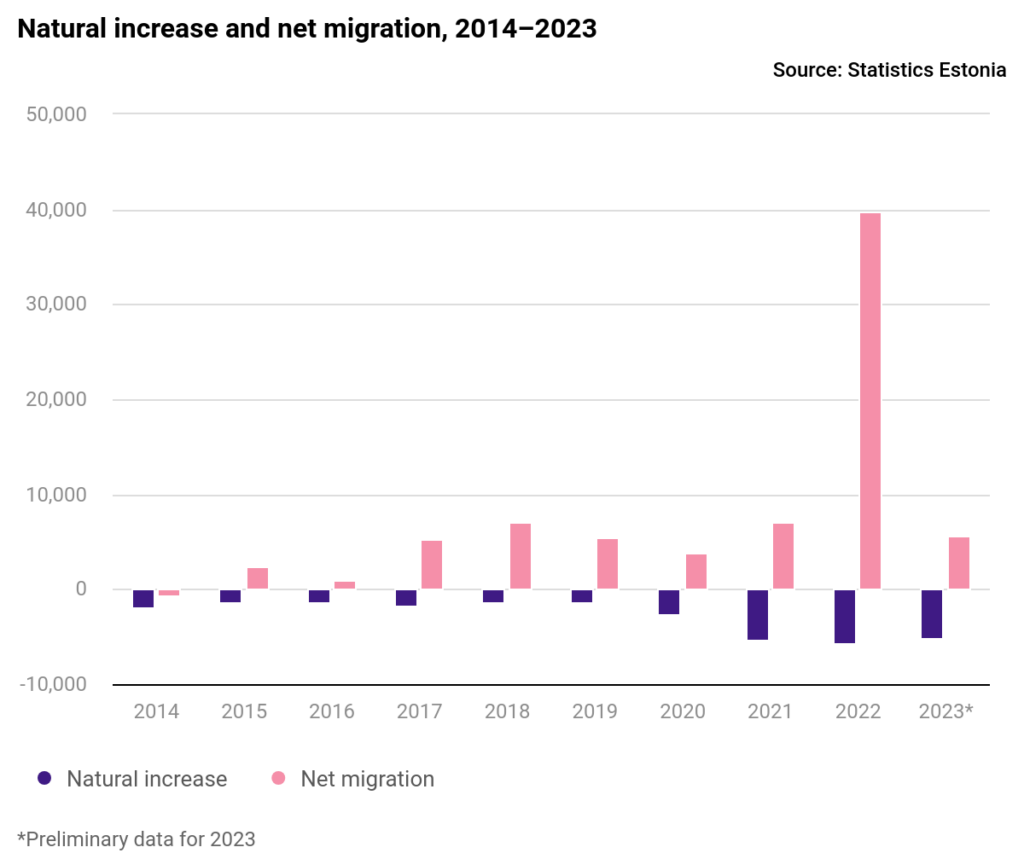According to preliminary data from Statistics Estonia, the population of Estonia on 1 January 2024 was 1,366,491, which is 607 people more than on the same date a year ago; the country’s population grew due to immigration – the number of births is the lowest in the last 100 years.
In 2023 there were 10,721 births and 15,832 deaths in Estonia. According to the data on registered migration, 20,209 people immigrated to Estonia and 14,491 people emigrated from Estonia. Compared to the previous year, the number of births, deaths and immigrants has decreased, while the number of emigrants has increased, according to Statistics Estonia, the country’s official statistics agency.
Terje Trasberg, a senior analyst at Statistics Estonia, said that 2023, like 2022, was characterised by a record low number of births, 925 fewer than the year before.
“In 2023, there were 5,111 fewer births than deaths, while 5,718 more people moved to Estonia than left. Therefore, the positive net migration outweighed the negative natural increase and helped maintain a slightly positive population change,” Trasberg said in a statement.
Number of births at an all-time low
A total of 10,721 children were born in 2023, the lowest number of births since 1919, when statistics began to be consistently published. This is the first time that the number of births has fallen below 11,000. Last year’s figure was also lower than the birth rate in 2022, which was the lowest in the last 100 years.

“There are several reasons for the low birth rate. The current childbearers are largely from the small generations of the 1990s, but the decline is much steeper than the number of women leaving active childbearing age would explain,” said Trasberg.
Even more than demographics, fertility rates are being affected by the current situation in the country and the world – heightened economic and political uncertainty and a general rise in the cost of living have led families to postpone having children. The easing of the coronavirus crisis has not had a positive impact on the number of births. In 2022, the neighbouring countries of Latvia and Finland also reported the lowest number of births in a century, and according to preliminary data, a new negative record is expected in 2023.
The average annual number of deaths before the pandemic (2010-2019) was 15,545, and in both 2021 and 2022 the number of deaths was well above this average. In 2023, the number of deaths returned to pre-pandemic levels, with preliminary data showing 15,832 deaths, still about 300 more than the average for the previous decade.
Migration figures significantly lower than in 2022
According to the data on registered migration, 20,209 people immigrated to Estonia and 14,491 people emigrated from Estonia in 2023. This means that net migration was positive – arrivals exceeded departures by 5,718 people.
In total, 11 529 or 57% of all immigrants had Ukrainian citizenship. Compared with the previous year, the number of immigrants with Ukrainian citizenship fell by 21,688. Although the number of immigrants with Ukrainian citizenship was three times lower than in 2022, it was still several times higher than before the start of the full-scale war (in 2020: 2,374, in 2021: 3,047). According to the preliminary data, 6,515 Ukrainian citizens left Estonia.

“There were 4,451 Estonian citizens leaving and 2,865 citizens returning to Estonia – but Estonians often do not register their migration, so the share of Estonian citizens among registered migrants is small. In 2023, there were 747 immigrants with Russian citizenship,” Trasberg added.
“Unlike the provisional birth and death statistics, the provisional migration statistics are likely to be significantly revised, as the provisional figures are based on data from the population register, where people often do not change their data when they emigrate or immigrate. Statistics Estonia will supplement the migration data with data on unregistered migration and the revised data will be published in May”.

